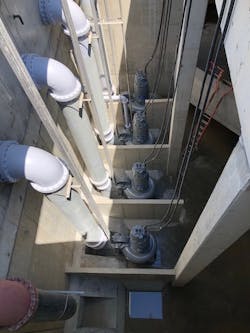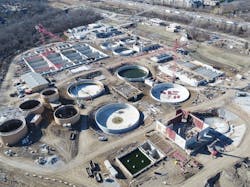Tomahawk Creek Wastewater Treatment Facility
Cost: $268 million
Location: Johnson County, Kansas
Year: 2020-12-31
Size: 19 mgd expansion
172 mgd peak wet weather flow
Owner: Johnson County Wastewater
Designers: Black & Veatch
HDR
Contractor: McCarthy Building Companies
Located in Johnson County, Kansas, the Tomahawk Creek Wastewater Treatment Facility project has been a goal of Johnson County Wastewater (JCW) to bring to fruition for more than 14 years.
The original treatment plant, a trickling filter plant, was built in the 1950s and only able to treat 7 million gallon per day (mgd) of flows. The Indian Creek and Tomahawk Creek watersheds and interceptors feed the plant, and flows can range between 15 mgd on average to above 150 mgd during wet weather.
Due to the limited capacity of the existing treatment plant, Johnson County sent most of the wastewater through a 72-inch interceptor across the state line to be treated in Missouri.
Multiple years of planning with KDHE finally achieved the approval Johnson County needed to begin constructing a treatment plant at the Tomahawk Creek WWTF site, which would more adequately be able to treat all average daily and wet weather flows.
The Tomahawk WWTF is a joint project of Johnson County Wastewater, Black & Veatch, HDR and McCarthy Building Companies. The team first wanted to divert all of the wastewater treatment plant flow during demolition of the old facility and construction of the new facility.
“It was not as simple as flipping a switch and all flows are diverted,” said BJ Peterson, vice president and McCarthy Building Co. project executive. “We spent more than a year sequencing and planning the specific steps we needed to take in order to make this happen.”
Critical steps before work began included building an overflow channel, since the site was in the middle of a flood plain. In order to accomplish the work, all interceptor flows would need to be diverted to Missouri for the duration of the project while the existing treatment plant was decommissioned, demolished and the new Tomahawk Creek WWTF was constructed.
Since the existing diversion structure needed to be demolished, the team built two new junction structures 30 feet deep to allow flow to be diverted around the existing plant through a 72-inch buried line.
There were two existing facilities that were rehabilitated for the project: the influent pump station and the digester complex. It was critical to keep the influent pump station operational during construction because the 72-inch interceptor that routes interceptor flows to Missouri for treatment is limited in capacity only up to approximately 80 mgd. Anything greater than that flow during wet weather would need to be bypassed into the overflow channel.
According to the team, the unique sequencing for the project required building a new peak flow pump station to handle these additional wet weather flows during construction so that the existing influent pump station could then be rehabilitated.
This sequence was critical for the project to allow for flows to arrive in the newly replaced influent pump station to pump into the new treatment plant process. Once the work was completed, all flows could then be shut off from Missouri.
The existing digester complex also posed a challenge because when the old digesters were decommissioned, there was residual 20-year-old solids that needed to be removed for the tanks to be rebuilt.
Other key obstacles included weather, underground lithology and maintaining crane access, but the team pushed forward nonetheless. Close collaboration with JCW operations staff ensured all permit and environmental regulations were followed, a crucial component of moving the project forward.
The new treatment plant will treat 19 mgd on average and have the ability to treat up to 172 mgd at peak wet weather flows. Every day of working on the project, time was carefully spent detailing the coordination and flows through the site.
The team created a list of goals that included maintaining a fun, safe, collaborative and worry-free environment with an emphasis on team culture; focusing on teamwork with a commitment to delivering a seamless start-up and commissioning phase for the treatment plant; and exceeding expectations by being innovative and award-winning, while delivering an exceptional stakeholder experience.
Despite embarking on construction during the wettest year on record for Johnson County in 2019, the project persisted.
Initially, the cost model estimate was $60 million more than Johnson Countyʼs budget. The project team took another look at the overall budget compared to the current scope of work in the design. Soon enough, ideas were being thrown around to help get the project within budget. This quick resolution happened over the span of six weeks to ensure the project was on schedule for the first quarter of 2018.
Another hurdle the team found itself facing was the trickling filter plant experiencing flooding during wet weather conditions because the site is surrounded by the paths of Tomahawk Creek and Indian Creek. In the early days of excavation activities, it was discovered that the soil used for on site filling to raise the new plant out of the floodplain was unsuitable.
To determine the extent of the materials that could interfere with the success of the project, the team used old photos of the creekʼs path and discovered a history of landfill material being placed within the path of Indian Creek. Once these were identified, the project moved forward with the removal and replacement of unsuitable soils.
Preconstruction analysis of the site determined that due to the old path of the creek through the site, the underground lithology of the limestone bedrock layer would have varying elevations during excavation of the new plant basins. Due to the change in bedrock elevation, the project included 790 drilled shafts.
Tower cranes were selected for three of the main construction areas to build multiple structures at once. The cranes allowed the project to maintain schedule despite the weather challenges because they eliminated the accessibility issues for workers.
“During the past year, we had the wettest calendar year in Kansas, and it allowed us to continue and manage their work,” said John Keller, project manager for Black & Veatch. “They were able to work the next day and keep on schedule. With a wet ground, they would have been struggling with rubber tired cranes to get around the site. It allowed the contractor to not have big projects that would have delayed the project even more.”
At one point in construction, there were more than 300 craft employees working on site, supported by three tower cranes and three rough terrain cranes. According to estimates by JCW, the facility will save stakeholders more than $400 million in rates over the next 35 years. This was a result of the local labor force in Kansas City being limited, considering the area’s hot market and large projects starting, including the billion-dollar airport project.
Project Year: 2020-12-31Contractor: McCarthy Building Companies Designers: Black & Veatch HDROwner: Johnson County WastewaterLocation: Johnson County, KansasCost: $268 million Size: 19 mgd expansion 172 mgd peak wet weather flow
